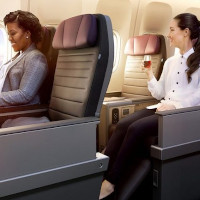Social distancing on an aircraft presents unique problems. Whereas in public, at the airport, and even waiting in line at the gate it is possible to keep your distance from your fellow travellers, once on board, the space between you is less than two metres, and in most cases, is far less than one metre.
Yet airlines are determined to give us the choice of flying, while at the same time artificially creating space between passengers, most commonly by blocking off the middle seats in single-aisle aircraft.
But is blocking off the middle seat effective as a form of social distancing?
Much depends on other factors, such as the personal hygiene of the passengers sitting around you – if they keep coughing into the air or into their hand and then touching surfaces, then it will cause potential infection of others. What airlines can do is bring in a range of other measures.
Air Quality
Airlines are quick to point out that the quality of air on their aircraft is extremely high. Qantas, for instance, says that “Our aircraft have the highest air quality, with HEPA (High Efficiency Particulate Air) filters installed in the filtration systems.
“These devices filter 99.999% of dust particles and airborne contaminants such as viruses and bacteria… These are the same type of filters that are used in hospital operating rooms.”
Allegiant, meanwhile, says “The air quality on our planes exceeds HEPA standards thanks to our VOC (volatile organic compound) filters, which remove additional organic compounds. On average, cabin air is changed every three minutes through a continuous flow of fresh and VOC-filtered air.”
The question, though, is whether social distancing is effective on an aircraft.
The answer appears to be that, taken together with the other measures the airlines are taking, the risks have been minimised as much as possible, but are still there. For each passenger it then becomes a matter of how essential the travel is.

